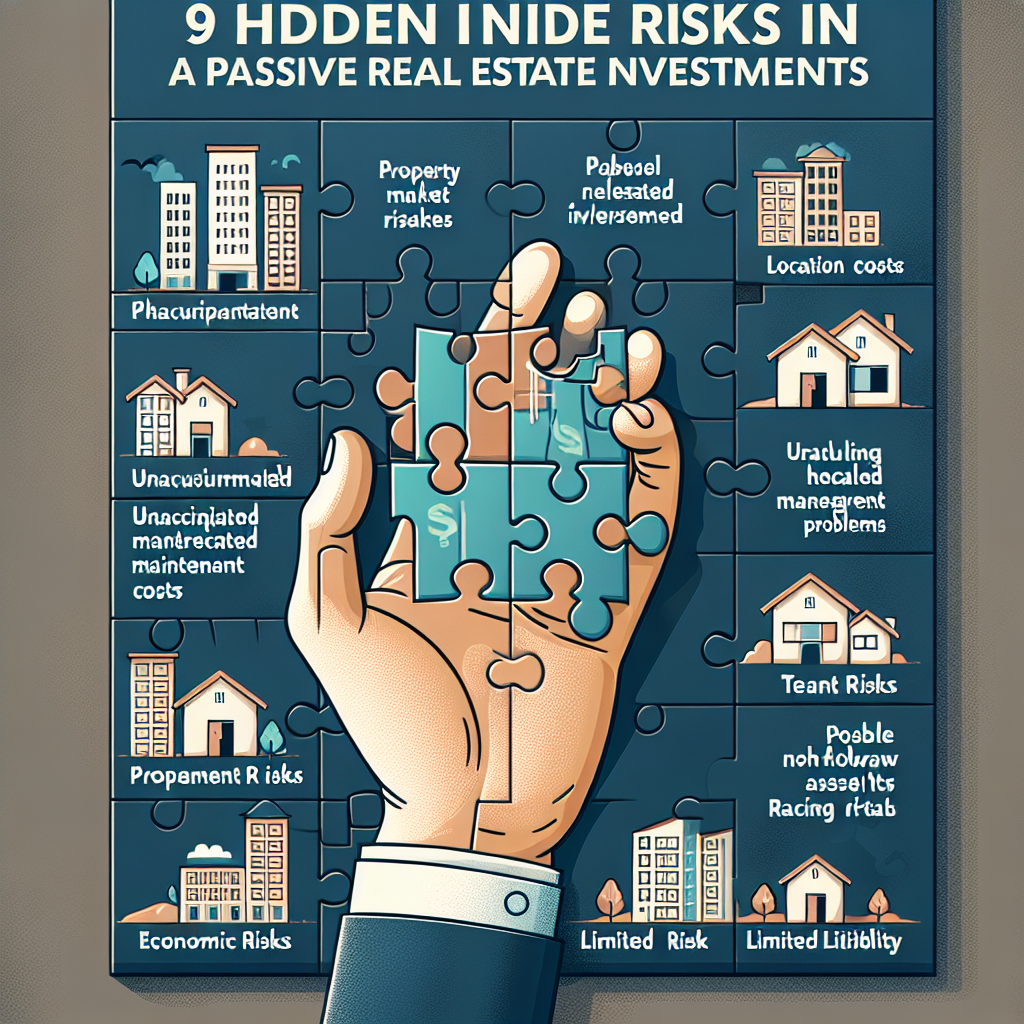-
Table of Contents
Uncovering 9 Hidden Risks in Passive Real Estate Investments

Passive real estate investments have gained popularity as a means to generate income without the day-to-day hassles of property management. However, like any investment, they come with their own set of risks. While the allure of passive income is strong, it’s crucial to understand the hidden pitfalls that could impact your returns. This article delves into nine often-overlooked risks associated with passive real estate investments, providing valuable insights to help you make informed decisions.
1. Market Volatility
Real estate markets are subject to fluctuations influenced by various factors such as economic conditions, interest rates, and local demand. While passive investments are designed to be less hands-on, they are not immune to market volatility.
- Economic Downturns: During economic recessions, property values can plummet, affecting the overall return on investment.
- Interest Rate Changes: Rising interest rates can increase borrowing costs, reducing the profitability of real estate investments.
- Local Market Conditions: Changes in local employment rates, population growth, and other factors can impact property values and rental income.
For example, the 2008 financial crisis led to a significant drop in property values, affecting both active and passive real estate investors. Understanding market trends and diversifying your investments can help mitigate these risks.
2. Illiquidity
Real estate is inherently illiquid compared to other investment types like stocks or bonds. This illiquidity can pose a significant risk, especially if you need to access your capital quickly.
- Long Holding Periods: Passive real estate investments often require long-term commitments, sometimes spanning several years.
- Difficulty in Selling: Selling real estate can be a time-consuming process, involving finding a buyer, negotiating terms, and completing legal formalities.
- Market Conditions: In a down market, selling a property at a desirable price can be challenging.
For instance, during the COVID-19 pandemic, many investors found it difficult to liquidate their real estate assets quickly due to market uncertainties and reduced buyer interest.
3. Management and Operational Risks
While passive real estate investments are designed to minimize hands-on involvement, they are not entirely free from management and operational risks.
- Property Management: The quality of property management can significantly impact the performance of your investment. Poor management can lead to higher vacancy rates, increased maintenance costs, and tenant dissatisfaction.
- Operational Costs: Unexpected operational costs, such as repairs, maintenance, and property taxes, can erode your returns.
- Legal and Regulatory Compliance: Ensuring compliance with local laws and regulations is essential. Non-compliance can result in fines and legal issues.
A case study involving a real estate investment trust (REIT) revealed that poor property management led to a 15% increase in vacancy rates, significantly impacting the overall returns for investors.
4. Sponsor Risk
In passive real estate investments, especially those involving syndications or REITs, the sponsor or management team plays a crucial role. Sponsor risk refers to the potential issues arising from the sponsor’s actions or decisions.
- Lack of Experience: Inexperienced sponsors may make poor investment decisions, leading to suboptimal returns.
- Misalignment of Interests: If the sponsor’s interests are not aligned with those of the investors, it can result in conflicts and unfavorable outcomes.
- Financial Stability: The financial health of the sponsor can impact the overall stability of the investment.
For example, a real estate syndication led by an inexperienced sponsor faced significant financial difficulties, resulting in delayed distributions and lower-than-expected returns for investors.
5. Leverage Risk
Leverage, or the use of borrowed capital to finance an investment, is common in real estate. While leverage can amplify returns, it also increases risk.
- Debt Servicing: High levels of debt require regular interest payments, which can strain cash flow, especially during periods of low occupancy or economic downturns.
- Foreclosure Risk: Inability to meet debt obligations can lead to foreclosure, resulting in the loss of the property and investment.
- Interest Rate Risk: Variable interest rates can increase borrowing costs, impacting profitability.
A notable example is the 2008 financial crisis, where many highly leveraged real estate investments faced foreclosure due to the inability to service debt amidst plummeting property values.
6. Tenant Risk
The performance of rental properties is heavily dependent on tenants. Tenant risk refers to the potential issues arising from tenant behavior and occupancy rates.
- Vacancy Rates: High vacancy rates can significantly reduce rental income and overall returns.
- Tenant Default: Tenants failing to pay rent or defaulting on leases can lead to financial losses and legal complications.
- Tenant Turnover: Frequent tenant turnover increases operational costs related to marketing, leasing, and property maintenance.
A case study involving a multi-family property revealed that a high tenant turnover rate led to increased operational costs and reduced net operating income, impacting the overall returns for investors.
7. Economic and Political Risks
Economic and political factors can have a significant impact on real estate investments. These risks are often beyond the control of individual investors but can influence the overall performance of the investment.
- Economic Recession: Economic downturns can lead to reduced demand for rental properties and lower property values.
- Political Instability: Political instability or changes in government policies can create uncertainty and affect real estate markets.
- Regulatory Changes: Changes in regulations, such as rent control laws or property tax policies, can impact the profitability of real estate investments.
For instance, changes in tax policies in certain states have led to increased property taxes, reducing the net income for real estate investors.
8. Environmental Risks
Environmental risks refer to potential issues arising from environmental factors and natural disasters. These risks can have a significant impact on the value and performance of real estate investments.
- Natural Disasters: Properties located in areas prone to natural disasters, such as hurricanes, earthquakes, or floods, face higher risks of damage and increased insurance costs.
- Environmental Contamination: Properties with environmental contamination issues, such as soil or water pollution, can face legal liabilities and reduced property values.
- Climate Change: Long-term climate change can impact property values and demand in certain regions.
A case study involving a coastal property revealed that frequent hurricanes led to increased insurance costs and reduced rental income, impacting the overall returns for investors.
9. Fraud and Mismanagement
Fraud and mismanagement are significant risks in passive real estate investments, especially in cases where investors have limited control and oversight.
- Fraudulent Activities: Instances of fraud, such as misrepresentation of property values or financial statements, can lead to significant financial losses.
- Mismanagement: Poor management practices, such as inadequate maintenance or improper financial management, can erode the value of the investment.
- Lack of Transparency: Limited transparency and communication from the management team can make it difficult for investors to assess the performance and risks of the investment.
A notable example is the case of a real estate investment firm that was found guilty of misappropriating investor funds, leading to significant financial losses for the investors.
Conclusion
While passive real estate investments offer the potential for attractive returns with minimal hands-on involvement, they are not without risks. Understanding and mitigating these hidden risks is crucial for making informed investment decisions. From market volatility and illiquidity to management and operational risks, each factor can significantly impact the performance of your investment. By conducting thorough due diligence, diversifying your investments, and staying informed about market trends and regulatory changes, you can better navigate the complexities of passive real estate investments and enhance your chances of achieving your financial goals.
In summary, the key takeaways for investors considering passive real estate investments are:
- Be aware of market volatility and economic conditions that can impact property values and rental income.
- Understand the illiquid nature of real estate investments and plan for long-term commitments.
- Evaluate the quality of property management and operational practices to ensure optimal performance.
- Assess the experience and financial stability of the sponsor or management team.
- Consider the risks associated with leverage and debt servicing.
- Monitor tenant behavior and occupancy rates to mitigate tenant-related risks.
- Stay informed about economic, political, and regulatory changes that can impact real estate markets.
- Be aware of environmental risks and the potential impact of natural disasters and climate change.
- Conduct thorough due diligence to avoid fraud and mismanagement.
By taking these factors into account, you can make more informed decisions and enhance the potential for success in your passive real estate investments.








